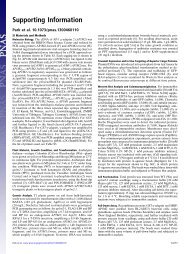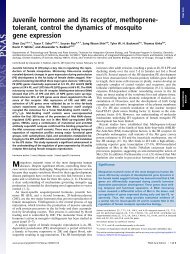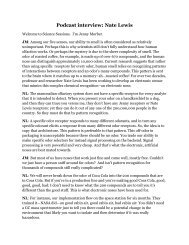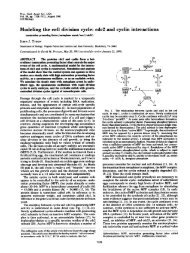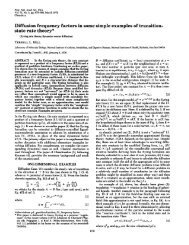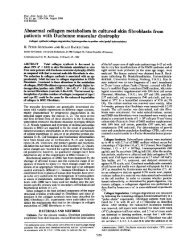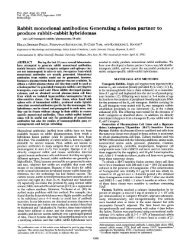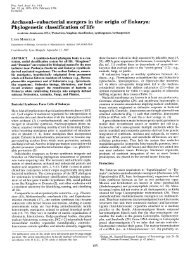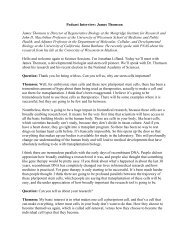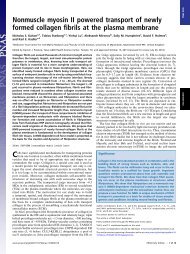Supporting Information
Supporting Information
Supporting Information
Create successful ePaper yourself
Turn your PDF publications into a flip-book with our unique Google optimized e-Paper software.
Table S3. Cross-cultural congruence in plant use in hot nodes<br />
%totalflora included % medicinal hits<br />
% gain in medicinal hits included<br />
compared with random<br />
Significance in<br />
gain (P value)<br />
Medicinal floras 21.97 25.62 16.65 0.2657<br />
Cardiovascular/blood purity 10.73 16.43 53.14 0.0673<br />
Dentistry/mouth 27.78 32.87 18.33 0.2015<br />
Gastrointestinal 15.39 21.35 38.77 0.0822<br />
General 29.41 26.18 −10.99 N/A<br />
Gynecology/fertility 30.81 32.43 5.25 0.4355<br />
Musculoskeletal 12.78 18.50 44.70 0.0833<br />
Neurology 25.95 33.68 29.80 0.0701<br />
Ophthalmology 10.59 21.01 98.33 0.0017<br />
Other 22.13 30.95 39.84 0.0415<br />
Otorhinolaryngology 14.59 25.92 77.61 0.0043<br />
Respiratory/pulmonary 14.81 19.72 33.17 0.1493<br />
Skin 25.03 31.50 25.87 0.1049<br />
Urinary 13.50 18.42 36.43 0.1230<br />
Average categories 19.50 25.30 37.71 0.1057<br />
Figures are the average from the six tests to investigate the extent to which hot nodes of each region (source region) can predict the medicinal plant use in<br />
the other two regions (target regions). The first column of data shows the percentage of the total flora of the target regions included in the hot nodes of the<br />
source region, using the option “nodesig” in PHYLOCOM v4.1. The second column shows the percentage of medicinal plants of the target regions found in<br />
those nodes. The third column shows the percentage of gain in medicinal hits achieved by sampling those nodes, compared with random sampling. Results are<br />
summarized for the medicinal floras of Nepal, New Zealand, and the Cape of South Africa, and for 13 categories of conditions. P value in bold is the one that<br />
remains significant after a Bonferroni correction of the α-significance level. Note that in uncorrected data, 1/20 significant comparisons may be spurious (type I<br />
errors), but the Bonferroni correction adjusts the α-threshold so the study-wide error rate remains at 0.05. N/A, not applicable<br />
Table S4. Similarities between the floras of Nepal, New Zealand,<br />
and the Cape of South Africa based on the Sørensen Index (ref. 1)<br />
at the genus level<br />
Region Nepal New Zealand Cape of South Africa<br />
Nepal 1<br />
New Zealand 0.28 1<br />
Cape of South Africa 0.37 0.34 1<br />
1. Sørensen T (1948) A method of establishing groups of equal amplitude in plant sociology based on similarity of species and its application to analyses of the vegetation on Danish<br />
commons. Biol Skr 5:1–34.<br />
Table S5. Significance of agreement in lineages used between<br />
pairs of medicinal floras when genera used in more than one<br />
region are removed<br />
Region Nepal Cape of South Africa New Zealand<br />
Nepal —<br />
Cape of South Africa P < 0.001 —<br />
New Zealand P = 0.005 P = 0.021 —<br />
Significance was assessed by comparing observed values of pair-wise distances<br />
to those from 10,000 random comparisons per case and P values were<br />
the frequency of randomizations with smaller pair-wise distance.<br />
Saslis-Lagoudakis et al. www.pnas.org/cgi/content/short/1202242109 6of25



